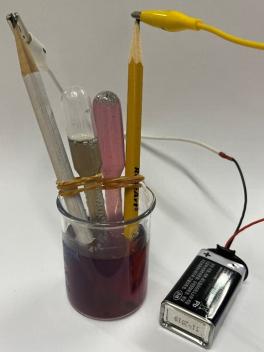Water Electrolysis with Biobased/Low Hazard Indicators – Red Cabbage Juice or Pea Flower Tea

Summary
Electrolysis of water is carried out using biobased/low hazard indicators to help illustrate the reaction.
Key Chemistry References for this activity:
1) Skinner, J. F. “Red Cabbage and the Electrolysis of Water.” J Chem. Educ., 1981, 58, 1017. https://pubs.acs.org/doi/pdf/10.1021/ed058p1017.1
2) Hugerat, M.; Abu-Much, R.; Basheer, A.; Basheer, S. “Using Inexpensive to Free Materials to do Electrolysis Experiments with All School Ages.” Chem. Educ. J., 2009, 13. http://www.edu.utsunomiya-u.ac.jp/chem/v13n2/13M_Hugerat/M_Hugerat.html
Additional Credit to Kathy Hall from Hilltop Heritage Middle School (retired) who shared her experience teaching the resource developed by the University of Washington Clean Energy Insitute (https://www.cei.washington.edu/lesson-plans/electrochemical-chameleon/)
Key Chemistry References for this activity:
1) Skinner, J. F. “Red Cabbage and the Electrolysis of Water.” J Chem. Educ., 1981, 58, 1017. https://pubs.acs.org/doi/pdf/10.1021/ed058p1017.1
2) Hugerat, M.; Abu-Much, R.; Basheer, A.; Basheer, S. “Using Inexpensive to Free Materials to do Electrolysis Experiments with All School Ages.” Chem. Educ. J., 2009, 13. http://www.edu.utsunomiya-u.ac.jp/chem/v13n2/13M_Hugerat/M_Hugerat.html
Additional Credit to Kathy Hall from Hilltop Heritage Middle School (retired) who shared her experience teaching the resource developed by the University of Washington Clean Energy Insitute (https://www.cei.washington.edu/lesson-plans/electrochemical-chameleon/)
Safety Precautions, Hazards, and Risk Assessment
- Red Cabbage or Pea Flower Tea
- magnesium sulfate heptahydrate CAS #10034-99-8 (on the Safer Chemical Ingredient List as a Processing Aid and Additive- https://www.epa.gov/saferchoice/safer-ingredients)
- hydrogen gas CAS #1333-74-0 (Generated in experiment)
- oxygen gas CAS #7782-44-7 (Generated in experiment)
- magnesium sulfate heptahydrate CAS #10034-99-8 (on the Safer Chemical Ingredient List as a Processing Aid and Additive- https://www.epa.gov/saferchoice/safer-ingredients)
- hydrogen gas CAS #1333-74-0 (Generated in experiment)
- oxygen gas CAS #7782-44-7 (Generated in experiment)
File (PDF, PPT, image, etc)
File (PDF, PPT, image, etc)
Creative Commons License

This work is licensed under a Creative Commons Attribution-NonCommercial-ShareAlike 4.0 International License.


